I had been meaning to go to a breakfast viewing party to watch the inauguration. I wanted to celebrate this amazing event amidst a community, to look across the room at faces that reflected my own inner joy and wonder. To be part of a collective whole. To be proud together.
Unfortunately, the Cold That Will Not Die made staying in my room in my pajamas the only real option. And the fact that every time I tried to put on some eye make up while getting dressed, I’d look at the coverage on the TV screen, start to cry and then have to start all over again.
Despite missing out on a communal viewing experience, small moments of inaugural joy kept popping up throughout the day.
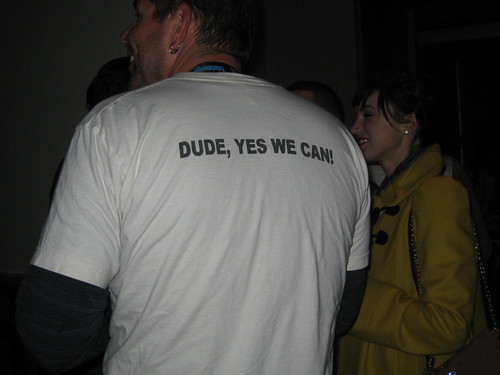
When I boarded the shuttle to go to a screening of We Live in Public, my entire section was abuzz with talk of documentaries. Two guys compared Tyson and Thriller in Manila, and then a third weighed in with his thoughts on Paul Saltzman’s Prom Night in Mississippi, which is about racially integrating the prom at Charleston High School. My shuttle-mates and I all marveled at the fact that we had just seen our first black President take the oath of office, yet just last year – 2008 – was the first time this school had had an integrated prom.
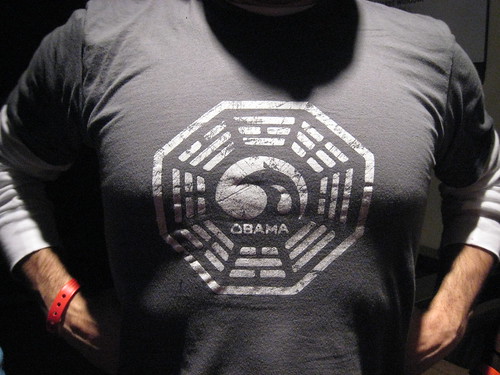
Obama fever, Lost-style
(though I'm sure the Dharma Initiative had nothing to do with his winning the election)
When Sundance programmer Caroline Libresco introduced the screening of We Live in Public, she began by linking the mission of the festival to the events of the morning. She said, “I’m proud to be part of an organization that presents all different points of view. That’s what democracy is.”
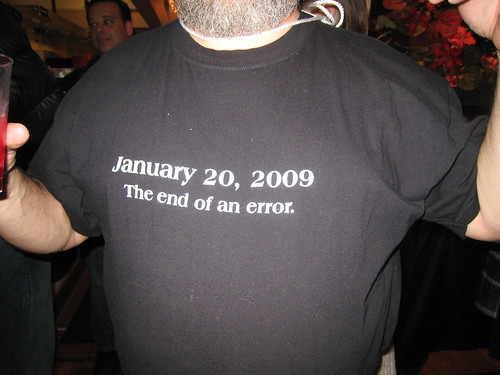
Even the Sundance Channel party later that afternoon at 350 Main incorporated the inauguration, with servers in shirts that featured the slogan, “1.20.09 for a change.”

Later that evening at the Kodak party, I ended up talking with a woman who, in the midst of the festival, had flown to DC and back to witness the historic event in person. She told us her stories, showed us her buttons, and made me feel one small step closer to being there.

After Art & Copy, I dashed down the hallway of the Holiday Village to go see a documentary about media of a very different sort. Anders Østergaard’s Burma VJ is about the Democratic Voice of Burma (DVB), an underground network of videographers dedicated to reporting news from one of the most closed countries in the world.
The film won the Joris Ivens Prize at the International Documentary Festival Amsterdam (IDFA) 2008 and was acquired by HBO for broadcast in 2010, but if you’re lucky, you’ll be able to catch this powerful film on a big screen sometime before then.
Østergaard’s film is told through “Joshua,” a 27 year-old video journalist whose real identity is kept secret for security reasons. Originally, Østergaard set out to make a more modest film about the lives of the secret reporters but in the midst of shooting the doc, Burma's Buddhist monks rebelled against the country's ruling military junta, providing the filmmaker with a much larger story to tell.
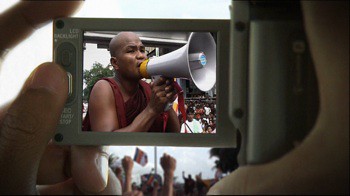
Joshua is forced to flee to Thailand, where he takes on a tactical role for the DVB, coordinating the VJs efforts with those of the monks. The film uses both original footage shot by the DVB and reconstructed scenes to convey the events of September 2007 in Burma. With the foreign media shut out and Internet connections severed, the VJ's footage is the only record of the uprising that made it out to the rest of the world.
Joshua’s face is never shown on screen in the film, and at first I found this off-putting. Eventually, though, it enabled me to experience the events as he was experiencing them. Burma VJ does what a good documentary should – it puts the audience inside of a situation they would never have the opportunity to witness firsthand.

I’ll be talking with Anders later in the week about his film, so check back over the next several weeks for a more in-depth look at the film. Here's a look at the trailer.
Saturday dawned cold and clear. Unfortunately, in addition to sunny skies and mild weather, it also brought a return of the cold I thought I had left back in Los Angeles. But there were movies to see, so I stuffed my bag with tissues and myself with DayQuil and headed out for a 9:15am screening of Art & Copy, Doug Pray’s (Surfwise, Hype!, Scratch) new film about advertising’s effect on modern culture.
The night before, I had attended a press roundtable with Pray and the advertising titans featured in the film. Pray said that the film started as a tribute piece, something with which he he was never quite comfortable. He wasn’t sure where it was going to go, so he kept shooting and shooting to find the story. He says that eventually, “the energy of the subjects changed the film.”

The advertising industry still comes out of Art & Copy smelling pretty darn rosy, but audiences at least get a glimpse into the hearts and minds of those who want it to be the best it can be. George Lois, the loud, Bronx ad man famous for his shocking Esquire covers, says in the film, “Advertising can be, and should be, and at times has been revolutionary.”
The film opens with the sounds of familiar jingles such as “I Wish I Were an Oscar Meyer Weiner” and goes into the story of how the business evolved from a Mad Men-esque old boys network into a hot industry that attracted creative, cutting-edge talent. The action that precipitated this change? Simply putting the art director and the copywriter in the same room.
The audience learns the history behind some of America's most famous ad campaigns, including "I Want My MTV," "Just Do It,” and “Got Milk?" Throughout the film, statistics about media consumption, the advertising business and the amount of money spent on advertising are set against images of billboard construction and satellite launches, giving the audience a sense of both the local and global reach of the industry.
In addition to the agency vets, Pray also follows Chad Tiedeman, a billboard “rotator” whose family has been in the business since the 1930s. At the beginning Tiedeman says that he doesn’t know any of those who create the ads that he hangs. By the end of the film, watching Chad hang an Apple iPod banner, the audience will feel like they do.
During the Q&A following the film, someone in the audience asked how filmmakers can apply some of the ideas explored in the Art & Copy to marketing documentaries. Pray responded, "A film is a film. The first thing to do is get rid of the "D" word. Treat it as a cinematic experience, and then sell that experience to the audience."
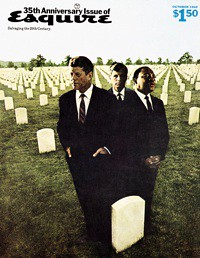 FOR MORE:
FOR MORE:
DOCUMENTARY magazine article on Pray's previous film Surfwise
George Lois's Esquire covers
Crew Labs: a competition for independent filmmakers with a prize of a marketing package worth $100,000
Broadband Jungle is reporting on the new user-friendly WhiteHouse.gov:
YouTube embeds from the White House homepage? Obama's cracking new media team didn't lose a second and relaunched what appears to be a cleaned up and user-friendly WhiteHouse.org while the nation was watching the inauguration this morning.
There's even a statement from Macon Phillips, Director of New Media on the newly-established White House Blog:
'A short time ago, Barack Obama was sworn in as the 44th president of the United States and his new administration officially came to life. One of the first changes is the White House's new website, which will serve as a place for the President and his administration to connect with the rest of the nation and the world.
Millions of Americans have powered President Obama's journey to the White House, many taking advantage of the internet to play a role in shaping our country's future. WhiteHouse.gov is just the beginning of the new administration's efforts to expand and deepen this online engagement.
Just like your new government, WhiteHouse.gov and the rest of the Administration's online programs will put citizens first.'
Now that's progress we can believe in! For the full report, check out Broadband Jungle or the government's site itself at http://www.whitehouse.gov.
All dealmaking and even text messaging came to a stop yesterday morning (at least in our condo) to watch the triumphant and inspiring inauguration of our 44th President.

I was fortunate to watch the festivities at a lovely little impromptu gathering put together by Annie Roney and her partner Christine of Roco Films. Annie was kind enough to pass out not only celebratory champagne, but also tissues, as many in the group (including the usually unsentimental me) became choked up watching the proceedings. I think it was the only time in my life when I've been completely happy to be a part of something that major. I'm usually on the outside looking in, but this time I was proud to be in and among my--yes--fellow Americans.
Interestingly, many in the room were actually from the UK, and they seemed equally moved and transfixed by Obama and his message as we Yanks were. To me, that was a small reminder that our stock in the rest of the world just increased tenfold (even if the Dow did not).
I'd hoped to stand in line to see an early AM screening of World's Greatest Dad at 8:30AM. But as much as I really wanted to be there, I also didn't want to be the guy telling his grandchildren he went to see a movie starring Robin Williams and directed by Bobcat Goldthwait during one of the most momentous events in his lifetime.
Parting shot: on my flight back to LA was Laura San Giacomo, who had been in town for the 20th anniversary tribute (yes, you're old) to Sex, Lies and Videotape. Back in 1989, Sex, Lies was "the" critically anointed masterpiece to arrive in theaters on a wave of Sundance love. Personally, it marked the first time that I, then in college, had really heard or paid attention to the festival. So I found it fitting that Ms. Giacomo was on my flight (though I couldn't bring myself to ask for a pic).
It's no documentary, but sometimes it felt like one. Here's a toast to Park City's history with a little glimpse of 1989's finest:
I know a lot of people come to Sundance and see four or five movies a day. Every single day. Well, I finally managed to see two in one day, and they were both very fitting for MLK Day/pre-inaugural viewing, as they dealt with the politics of speech, culture, race and prejudice. Liz Garbus' new film, Shouting Fire, about the battles to engage, protect and uphold First Amendment rights, and Robert Townsend's Why We Laugh, a chronicle of the sociological importance of 20th Century African-American comedy, made an interesting--if accidental--double bill. That is if you call a "double bill" two films in two different theaters, separated by a wait in the cold and a wacky shuttle ride. I guess I would (did).
See this clip from Why We Laugh on YouTube here.
I'm unaware of the distribution plans for Why We Laugh (which boasted an impressive collection of interviewees and some choice clips from the likes of Redd Foxx and the great Robin Harris) but Garbus' film airs on HBO in July, along with an (appropriate) outreach program to schools. In the interest of full disclosure, I should mention that her father Martin Garbus, who is the connective 'glue' of the film (and one of the most renowned First Amendment attorneys in the country), also appeared in my own This Film Is Not Yet Rated. I enjoyed interviewing him then, and I enjoyed seeing him take a central role here - he's a wise and engaging man, and he was certainly in good hands here with his talented daughter.

I would have made it three films except I messed up my scheduling, as I headed over to Slamdance in the afternoon to see Lost Sparrow, a film which was part of IDA's own Fiscal Sponsorship program. Only it wasn't actually playing until Tuesday. Duh on my part. Slamdance looked like it had some fun offerings: the latest from Broken Lizard, The Slammin' Salmon, and Smile Til It Hurts, the doc about legendary kitschmeisters Up With People.
As for the Celeb Beat, I left the Cinema Eye honors and found myself crossing paths with Robin Williams, and then later overheard someone on a cell phone say, "Yeah, man, Ron Jeremy's here."
And it wouldn't be a Sundance without Ron Jeremy, right?
John Waters once wrote that he wished he could make a film in which the crowd scenes contained only famous people.
The documentary version of that occurred on January 19 with Thom Powers and AJ Schnack's announcement of the nominees for this year's Cinema Eye Awards, in the Absolut section of the Queer Lounge simply wall to wall with some of the most notable nonfic filmmakers and tastemakers in the world. Powers and Schnack, with help co-presenters/advisors Joe Berlinger and Laura Poitras, revealed an impressive slate of films spanning the last year, recognizing overall achievement as well as artistry in music, animation, and production (that's right - producers! In documentaries, there's more than meets the Cinema Eye). Joe Berlinger, here with his new film Crude, acknowledged his support of the CE's recognition of the craft of filmmaking, and not simply the merit of the subject matter.
A full list of nominees appears here on AJ's All These Wonderful Things blog.
And here's a pic snapped by yours truly of Schnack In Action (Schnack-tion?):

Plus, here is a video of the announcement:
Above is a cell-phone glimpse of IDA's Park City house party, held Sunday, January 18 in a beautiful private residence in Deer Valley.




The event, thanks to the incredible generosity of the Truman Group of Chicago, seemed like a terrific success -- good food, wine, music, conversation and company -- and I think everyone there enjoyed themselves. (And hopefully no one got lost trying to get there.) A past IDA President was heard to remark, "How is it that the documentary organizations are throwing the nicest parties?"



Party coverage made it into The New York Times' Carpetbagger blog. Check it out here. So if you're reading this and weren't able to make the trek…maybe next year? Can I entice you with the words, "prosciutto-wrapped asparagus"?
All photos by Cassie Wright.
First, a thought of the day: "Sometimes, pithy Sundance wisdom comes not from moguls, but from 'the little guy' fighting against life's petty cruelties."

Now on to the day's post: Yes, that's right, I actually managed to see a real live documentary today (for those of you who wondered why the hell you were reading yesterday's column). It was Davis Guggenheim's It Might Get Loud and it was pure, unmitigated pleasure. The film's premise almost sounds like a setup for an old joke: "So, Jimmy Page, The Edge, and Jack White walk into a soundstage filled with guitars..." But it's anything but a joke; for anyone musically inclined, it's pure bliss.
Many music documentaries are empty shells; they don't inspire you to pick up an instrument or even listen to the tracks. This one goes deep, in terms of how the musical sausage is actually made. Hear the Edge's four-track demos recorded on a cassette tape that looks like it came from Radio Shack! See the foyer in Jimmy Page's house where the drum track to "When The Levee Breaks" was recorded! And understand where Jack White found his musical soul. I can only guess that the music budget for this film was probably more than entire films I've made and yet lower than the bailout funds going to banks. But it was truly impressive, not because of the expense, but because they could actually afford all the necessary tracks they had to have (and live performance footage). You didn't leave thinking, "How could they make that film and not have ______ (fill in the song here)?" They had 'em all.
The high point of the film, watching these three guys jam, unexpectedly and truly brought tears to my eyes, because they related to each other exactly the way any three garage-band musicians who sit down to jam try to figure out what the lead guy is playing to riff off of it. And I could relate to that experience.
Extra special bonus was Jack White himself taking the stage for the Q&A.
I had offered Davis (who debuted An Inconvenient Truth in that very theater -- the Library -- at Sundance three years prior) a tagline for his trailer back when he was on a panel we did Film Independent last fall. And I still stand by it: "The director who saved the world...is about to rock your world." (You have to say it with the right, "trailer-guy" voice for it to work). Come on Sony Classics, it's there for the taking.
Below is some video of me outside the theater in the cold waiting for delightful fellow Board Member Laurie Ann Schag to show up with my ticket. Without her, I'd have missed it all!
Started the day off with an early morning screening of Passing Strange, Spike Lee’s filmed version of the Tony-winning rock musical. Early in the afternoon, I headed to the Vitamin Water house to interview both Mr. Lee and Passing Strange creator and star Stew.
During my time there, I experienced in full force the bizarro world that is now Sundance. Members of the cast and crew of the film feasted on a ritzy catered lunch (the ahi tuna app looked damn good, but no foodie love for the journos waiting to talk to Spike), and the fully stocked bar doled out schmancy Vitamin Water cocktails. The house was branded the hilt with Vitamin Water bottles in all colors and flavors adorning the walls. Meanwhile, I was waiting to interview the creators of a film that has no distribution, and has its story development roots in the Sundance Lab...about as indie as you can get.
After talking with both Stew and Spike (more on that later), I headed over to the PBS/ITVS party at the Riverhorse. I was greeted at the door by the lovely Cara white, and there were lots o’ non-fiction folk in attendance. ITVS’ Jim Sommers, Sr. VP of Content Management, welcomed the crowd by mentioning that 64 ITVS films have premiered throughout the years at Sundance, with 16 of them receiving awards. John Wilson, PBS’s SVP & Chief TV Programming Exec, spoke about this being a time of monumental transition that can be challenging but can also lead to new opportunities. He bragged about the fact that pbs.org receives more visits than the online outposts of ABC, CBS, Fox and NBC.
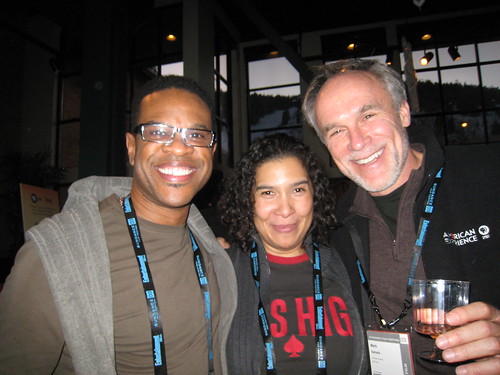
New Frontiers panelist Thomas Allen Harris, Sundance's Shari Frilot
and Mark Samels (executive producer, EARTH DAYS)
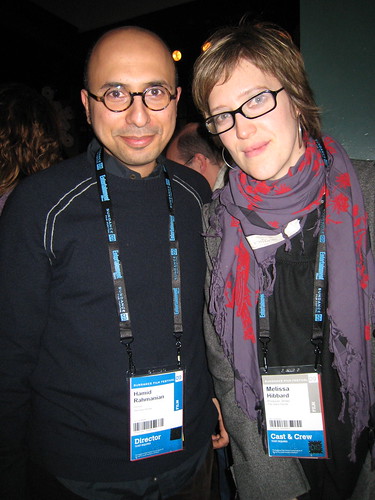
THE GLASS HOUSE director/DP/Editor Hamid Rahmanian and producer/screenwriter Melissa Hibbard

Filmmaker Adrian Belic and ITVS's Lois Vossen

A contemplative Stanley Nelson (WOUNDED KNEE)